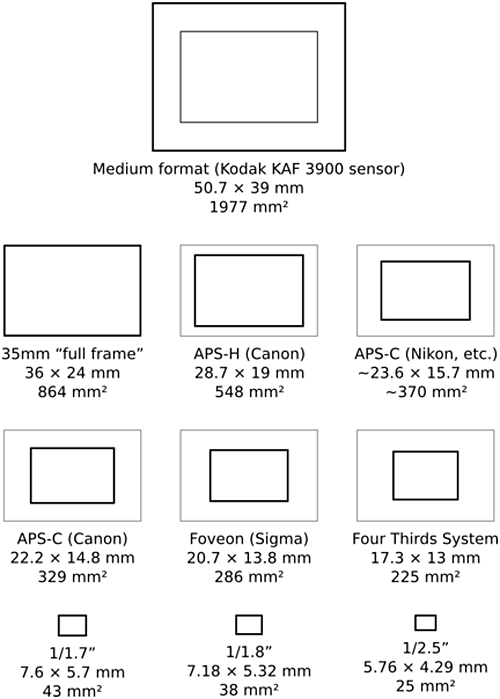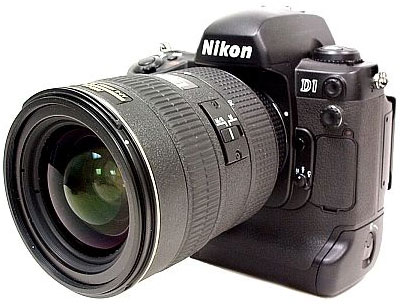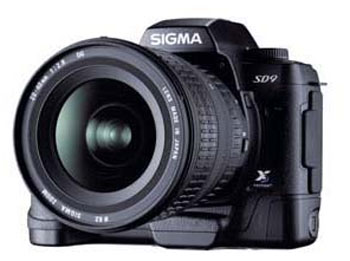The Digital Sensor: A Guide to Understanding Digital Cameras
by Wesley Fink on April 21, 2008 1:00 AM EST- Posted in
- Digital Camera
Sensor Size and Multipliers

Canon had become a dominant player in the SLR market after their successful launch of the EOS all-electronic mount for AF. Canon was also large enough with enough resources to develop and manufacture their own sensors. Canon launched a professional standard APS-H camera, with a 1.3X lens multiplier that used existing Canon 35mm lenses. Later, when Canon was ready to create a consumer digital SLR market they used a smaller 22.2x14.8mm sensor with an area of 328mm² and a lens multiplier of 1.6X. This is 38% the area of a full-frame sensor.
More recently, Canon has championed the full-frame sensor in their pro cameras and in their pro/amateur 5D model. Larger sensor manufacturing cost has dropped as digital sensors have evolved and it now appears likely the APS-H (1.3X lens multiplier) will eventually drop form the Canon line. Since no lenses depend on that image circle all current Canon full-frame lenses, such as those used with the APS-H cameras, will remain usable on the full-frame sensor pro models that will replace them.

Nikon, Pentax, and Minolta all had significant success in the 35mm film market, so all three had a vested interest in preserving their 35mm lens mount and keeping their current 35mm system users happy. However, none of these three had the resources to develop and manufacture their own sensors, so they partnered with sensor manufacturers to produce digital SLR cameras. In recent years that partner has been Sony, so all three manufacturers have basically adopted a larger 23.6x15.7mm sensor with a 1.5X lens multiplier.

Sony purchased the Photo Imaging division of Konica Minolta in 2006 and carried on the Minolta lens mount under the Sony brand. Today Sony both manufactures their own Sony brand cameras with Sony sensors and they continue to sell sensors to Nikon, Pentax, and Samsung.
Olympus was a huge player in the digital compact market as the market began its slow move to the digital SLR. While Olympus had been a very successful player in the film SLR market, they lost market in the SLR Auto-Focus wars kicked off by the success of the Minolta 7000. Olympus AF cameras remained a fringe product and Olympus eventually exited the market to concentrate on their compact digital offerings.

Olympus had a stake in the compact market remaining dominant and they had little legacy 35mm business to protect. Both developments made them late to the digital SLR market, but they made the best of it with a different approach than the other DSLR players. Olympus developed a new all-electronic DSLR lens mount and camera system based around a Kodak sensor with a 4:3 ratio instead of the 3:2 common in 35mm. With no legacy lenses to protect, the concept of lens multiplier is basically meaningless when talking about the Olympus DSLR system, but the diagonal is 1/2 the 35mm full-frame so lenses are equivalent to a 35mm lens at twice the focal length.
Olympus and its partners also made the 4/3 standard open - that is, it's available to any manufacturer. Currently Olympus, Panasonic, and Leica are producing 4/3 cameras and lenses but other manufacturers may join them in the future. Olympus is also now using sensors manufactured by Panasonic, a development partner, in their 4/3 cameras.

Sigma is best known as an independent lens manufacturer, but they have been producing SLR camera bodies for almost 30 years. Sigma introduced their first digital SLR with the SD9 in 2002. Sigma is the only DSLR manufacturer to use the unique Foveon sensor, which captures all three colors in a digital image in three layers - red, blue green - on a sensor. All other current digital sensors are based on Bayer sensors, which capture all three colors in mosaic patterns on a single sensor layer. Colors are then restored by an interpolation process called demosaicing, which theoretically converts the three color mosaics into smooth full-color images.
For this discussion, the current Sigma SD14 should be considered a niche DSLR player with very small market share. The Foveon sensor falls between 4/3 and the Canon 1.6 in size and has a 1.7X lens multiplier. Sigma is the only third party lens maker to produce lenses for all the camera systems discussed here. Some are full-frame designs with digital coatings to mount on full-frame or smaller digital sensor SLRs. Other designs are based on the largest 1.5X APS C image circle and are designed to work with smaller DSLR sensors ranging from 1.5X to 2X lens multiplier.










72 Comments
View All Comments
Johnmcl7 - Monday, April 21, 2008 - link
On page 4:"The Foveon sensor falls between 4/4 and the Canon 1.6 in size and has a 1.7X lens multiplier."
I assume this should read '4/3'
Obvious question is what about Fuji? While I realise they re-use Nikon bodies and lenses, the discussion about Bater and Foveon makes no mention of Fuji's sensor. While it is more conventional than the Foveon, it's not just a bog standard bayer sensor and while Fuji are a minor player, so are Sigma.
For those who are not familiar with Fuji's design, they use two photodiodes at every point one larger and one smaller with the two combined to produce a single pixel in the output image. The idea is that these pair of pixels can capture more extended dynamic range than a standard bayer sensor of the same size. The latest version of this sensor is in the Fuji S5 Pro however it's limited to just 6MP although I can't remember if they still produce 12MP files from this. The S5 itself is basically a Fuji version of the very good Nikon D200 body although Nikon have of course moved on with the very impressive D300.
John
Wesley Fink - Monday, April 21, 2008 - link
Yes, it should have read 4/3 and the reference is corrected. The Fuji S3 was one of my favorite Nikon bodies and the dynamic range was certainly impressive in the studio.We did not mean to slight Fuji, but as one Nikon-mount body with a sensor that hasn't been updated in several years (the S3 and S5 sensors are the same as I understand it) we decided not to include the Fuji since there have been no sensor updates in quite a while.
Johnmcl7 - Monday, April 21, 2008 - link
"We did not mean to slight Fuji, but as one Nikon-mount body with a sensor that hasn't been updated in several years (the S3 and S5 sensors are the same as I understand it) we decided not to include the Fuji since there have been no sensor updates in quite a while. "I can't say I really agree there, given the article more focuses on concept in parts I think the S5 sensor is still relevent as it's something slightly different to the bayer sensor. The article refers to only Bayer and Foveon which implies there is nothing else, I think for completeness even if you don't go into any detail it's still worth mentioning Fuji are doing something else.
Also the S3 and S5 sensor are not the same, while they have the same amount of pixels it appears there's been some slight improvements although clearly not much. To be far to Fuji though, the Foveon sensor hasn't really come on much either - it's gone up very slightly in resolution with some small other changes but that's it pretty much. If the Foveon sensor had been just mentioned in passing I could definitely understand leaving Fuji with a similar mention but generally Fuji and Sigma are considered in the same boat as doing something a bit different although arguably with the Nikon body and mount Fuji have had more success.
John
melgross - Tuesday, April 22, 2008 - link
I never saw an advantage to their designs. I can't see what purpose having a smaller photo site on the sensor would do. It just has more noise, and less dynamic range than the larger sensor. I've read their papers on the subject, and they don't seem to have made a good case for it. Somehow, I think they understand that now.Johnmcl7 - Thursday, April 24, 2008 - link
"I never saw an advantage to their designs. I can't see what purpose having a smaller photo site on the sensor would do. It just has more noise, and less dynamic range than the larger sensor. I've read their papers on the subject, and they don't seem to have made a good case for it. Somehow, I think they understand that now."Are you referring to Fuji? If so, your information is incorrect - the last measurement I saw put the S5's sensor at slightly more dynamic range than the 35mm sensor in the Nikon D3. Their real problem at the moment seems to be resolution as well as having the older D200 based body.
John
strikeback03 - Tuesday, April 22, 2008 - link
I think Sigma (and Foveon) would be better off if Sigma could license a major player's mount, like Kodak did with the SLR/n and SLR/c. There are plenty of people who would like to have the sensor for the situations where it excels, but have no interest in a whole Sigma SA mount setup.pinto4402 - Monday, April 21, 2008 - link
I've been reading Anandtech for over 8 years now. I was a bit skeptical about your doing articles on digital cameras; however, this article put my reservations to rest. Very nicely done.I see why it makes sense for Anandtech to write about digital cameras. The nexus between computer tech and camera tech are very obvious if you've been following the trends. I'm a professional portrait photographer. In the last few years, it has become virtually impossible to remain in business unless you have a firm grasp on the latest camera tech as well as computer tech. I spend as much time on my computer as I do behind the camera. The camera has become a computer accessory (or vice versa). Many old timers who are hanging on to film are slowly being forced out. I'm somewhat of an old timer myself because I learned about photography when it was cool to have a darkroom, but I embraced digital equipment early.
Your graphs make it very easy to explain to people why their P&S (piece of s***) cameras are simply not adequate for serious portraiture. The MP count is marketing crap. As you demonstrated, it's the physical size of the sensor that matters.
Looking forward to part II of the series. Also, do you have any solid info on the introduction of 5D Mk II?
bjacobson - Tuesday, April 22, 2008 - link
"The MP count is marketing crap."Mostly. If you're willing to do some post processing yourself, the higher MP will enable you to decrease the IQ gap between the higher end DSLR and the ho-hum consumer camera. For this reason, since I wanted something compact and didn't really need a lot of optical zoom, I chose the Canon SD1100IS. 8MP, and while you begin to get noise at ISO400, more at ISO800, and tons at ISO1600, using a non-linear digital filter should correct most of that without blurring the image much (if at all).
strikeback03 - Wednesday, April 23, 2008 - link
Problem is that the camera has already blurred away lots of your detail at ISO 400 and up.http://www.dpreview.com/reviews/canonsd1100is/page...">http://www.dpreview.com/reviews/canonsd1100is/page...
Too bad there is no option to reduce/turn off the in-camera NR, for those of us who own a better program for it already.
Wesley Fink - Monday, April 21, 2008 - link
I wish I did have definitive info about the 5D Mark II launch, but the best info I have is this fall at Photokina. Rumors pop up every month that the new 5D will be here in a few weeks - and the last rumor was a definite April 22, which is tomorrow. Rumors are just that - rumors.